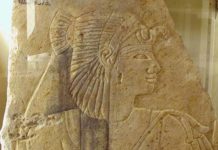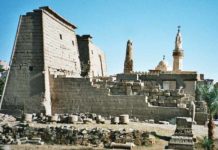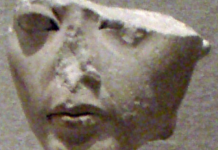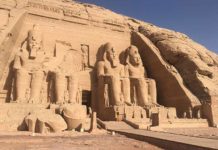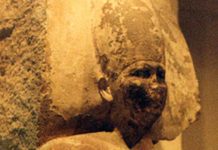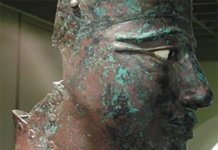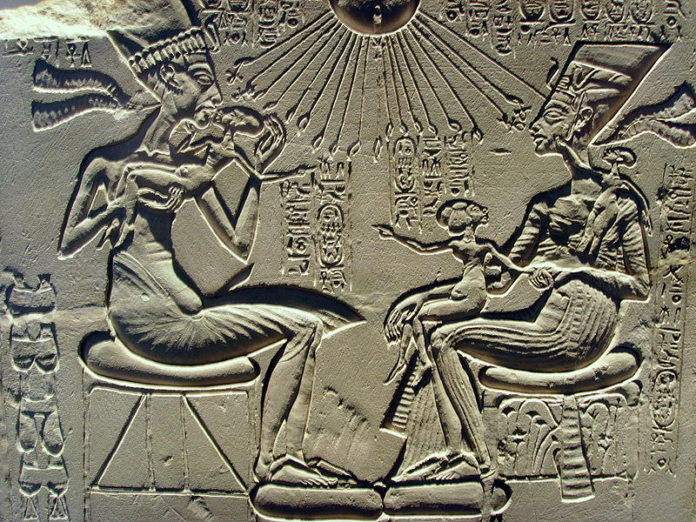
Pharaoh Akhenaten had six daughters by his chief wife Nefertiti, he married the elder two and the younger four died unexpectedly.
Meritaten
Their eldest child was born at Malkata towards the beginning of his reign, (c.1350 BC), her name means, ‘She who is beloved of Aten’. She is depicted with her parents and younger sister Meketaten on boundary stelae marking the city limits of her father’s new capital, Akhetaten, following the relocation of the royal court during the religious reformation.
In Year 12 (c.1338 BC), her father dedicated special chapels named ‘The Fan-Screens of Re’, to his mother – the dowager queen Tiye, and also to Nefertiti and Meritaten, that same year she is depicted with all her sisters in a scene portraying the Parade of Foreign Tributes from the tombs of court officials, Meryre II and Huya.
Until Year 12, Akhenaten had a secondary wife, Kiya, who seems to have fallen into disgrace as her name was hacked out from inscriptions and replaced with Meritaten who usurpued all of her monuments. Apparently she was married to her father – and many have suggested that they may have had a daughter together, Meritaten Tasherit – who died in infancy, however this may be speculation.
In Year 13, or 14, she appears with her parents and sisters, Ankhesenpaaten and Neferneferuaten upon scenes within the royal tombs at Amarna lamenting the loss of Meketaten.
During her maturity she held the title – Great Royal Wife, and it is believed she was married to the elusive pharaoh Smenkhare – who some have suggested could have been a half-brother and that they succeeded Akhenaten – but died within a year of his accession. It has also been suggested that her mother did outlive Akhenaten and ruled as Smenkhare together with Meritaten for almost a year, however both theories have not yet been proven, and the fate of Meritaten has not yet been discovered, nor has her mummy been recovered.
Her name appears on an ivory writing palette – which probably belonged to her, in the tomb of Tutankhamun – her younger half-brother. Also a sarcophagus belonging to her was found within KV55 – which has recently been proven to house the mummy of Akhenaten.
Meketaten
Their second daughter was born around Year 2 (c.1348 BC), and her name means, ‘Behold the Aten’. Meketaten is frequently depicted in artworks from Amarna, and features with Meritaten and Nefertiti along boundary stelae of the new city of Akhetaten. She features with all of her sisters at the Parade of Foreign Tributes, and it has been said that she was married to her father – and died, presumably in childbirth sometime between Years 13 and 14 (c.1337 and 1336 BC).
The death of Meketaten is depicted in the Amarna royal tombs, where she is depicted in an inert position, with Akhenaten and Nefertiti and their household in extreme lamentation, clutching each other for support and holding their heads in grief. In the background is a nurse holding a small child, with a fan-bearer providing shelter, which suggests the infant’s royal status – and has led people to assume that she died in childbirth.
However, the child held by the nurse beneath the fan-bearer may have in fact been a small child as opposed to a newly born baby, and at the time of Meritaten’s death she could not have been more than twelve or thirteen years old and a death in childbed seem unlikely. It is more probable that she died due to natural illnesses.
Like her elder sister Meritaten and the younger Ankhesenpaaten – she was probably married to her father for ceremonial reasons – to reflect the relationships between the goddess Hathor and her family, which had also inspired Akhenaten’s father, Amenhotep III to marry some of his daughters such as the Princesses Sitamun and Isis.
Within the same tomb, is another scene where Meketaten stands beneath a canopy, with her parents and three of her sisters, Meritaten, Ankhesenpaaten and Neferneferuaten Tasherit, who lament her loss and this scene appears to represent her rebirth. It is believed that she was buried in the royal tombs at Amarna with her grandmother, Tiye. To date, the mummy of Meketaten has not been found.
Ankhesenpaaten (later Ankhesenamun)
The third royal daughter was born around Year 5 (c.1345 BC) she later became the wife of her younger half-brother Pharaoh Tutankhamun, and following his death she was married to his successor, Pharaoh Ay, who was also her maternal grandfather.
Neferneferuaten Tasherit
She was the first princess to be born at Amarna, and was born around Year 8 (c.1342 BC). Neferneferuaten was named after her mother, Nefertiti, whose name was changed to Neferneferuaten when the royals changed their names to embrace the Atenist religion. Her name means ‘Beauty of the Beauties of the Aten’, with the epithet ‘Tasherit’ meaning ‘Junior’. She appears at the Parade of Foreign Tributes in Year 12, and at the scene mourning the loss of Meketaten. The future of this princess is uncertain.
Neferneferure
The fifth daughter was born around Year 8 or 9 (c.1342 or 1341 BC), her name means, ‘Beauty of the Beauties of Re’. She is depicted with all of her sisters during the foreign tributes parade, but it is likely that she died in Year 13 or 14 (c.1337 or 1336 BC), aged about five, as she is not depicted at the mourning scene for Meketaten. Neferneferure is depicted on a crouching position upon a box-lid discovered in Tutankhamun’s tomb.
Setepenre
Princess Setepenre, whose name means ‘Chosen of Ra’, was the youngest daughter and appears to have been born towards Year 9 (c.1341 BC), meaning she was about the same age as Tutankhamun. Setepenre is depicted with her sisters at the Parade of Foreign Tributes. It is likely that Akhenaten and Nefertiti’s youngest child died aged around three years of age, shortly before Meketaten, as she does not appear in the mourning scene.


